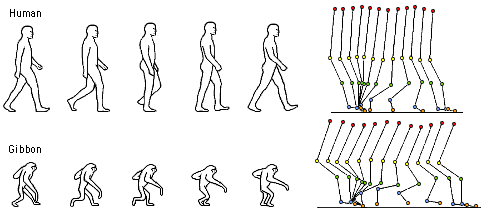Back to the Introduction index
![]() German version
German version
5. Locomotion |
Back to the Introduction index
![]() German version
German version
5. Locomotion |
Gibbons are completely arboreal (tree-dwelling) and have developed highly specialized forms of locomotion. Most anatomical adaptations observed in gibbons (such as the extreme elongation of the arms and hands) are related to their locomotion.
Most primates live predominately in trees, which give protection and security and serve as sleeping sites and food sources. Within this ecological niche, gibbons are additionally specialised in order to avoid competition for food from other animals: they are able to access the fruit and leaves on the thin, outer branches of the trees in the South-asiatic rainforest - this is called ëterminal branch feedingí. The only competitors who can follow gibbons to the thin branches are birds and smaller mammals (squirrels, flying foxes).
In order to optimise the use of the terminal branch niche, the gibbon locomotor repertoire became specialised in two directions: brachiation (swinging by the arms) and bipedalism (walking upright on two legs).
Brachiation (Figure 5.1) is not only an effective form of locomotion, and it also allows the gibbons to reach and harvest every fruit of a branch. Whereas most arboreal primates are limited to the feed on fruits they can reach by sitting or standing on the substrate (such as a branch), gibbons are, in addition, able to access the fruits hanging underneath the substrate, which increases the yield of each branch considerably. When an animal sits on a branch, its own weight lowers the branch and makes feeding from that branch more difficult. In contrast, the weight of a gibbon hanging below the branch serves to pull the branch towards the gibbon, which makes food collection easier (Figure 5.2).

Figure 5.1. White-handed gibbon (H. lar): Slow brachiation (after a photo series in Eimerl & DeVore, 1969, pp. 72-73).

Figure 5.2. Radius of action during feeding: a. macaque, b. gibbon (after Grand, 1972, p. 198).
Brachiation allows for very fast movement. It also enables gibbons to cross quite large gaps in the canopy, and the body weight can be distributed on branches that are relatively far apart. In a suspensory position, a gibbon hanging from hook-like hands is always in a stable equilibrium, whereas primates standing on legs usually have to invest energy to keep the balance.
Anatomical adaptations for brachiation occur mainly in the upper body parts. The long, hook-like hands and very long, strong finger-flexors help carry the weight of the body during swinging.
The most conspicuous adaption are the exceptionally long arms. They allow for a quick start and a high acceleration. The movement of the gibbon's body during brachiation resembles that of a pendulum and is subjected to similar physical forces.
The additional rotation of the body during brachiation produces high torsion loads in the upper arms. In order to counter these to some degree, the ball joint of the upper arm does not face as far forward as in humans and the other apes. As a result of the moderately expressed torsion in the gibbon humerus, the arms are hanging in a more lateral direction in the resting position (Figure 5.3).

Figure 5.3. White-handed gibbon (H. lar) in resting position with inserted illustration of the shoulder joint. Because of the moderately expressed torsion in the gibbon humerus, the arm appears to be laterally rotated away from the body (after Larson, 1988, pp. 457 and 458).
Gibbons walk upright on two legs more frequently than any other non-human primate, and bipedalism accounts for 10% of their behavioural repertoire. Comparisons are often made between bipedal locomotion in humans and gibbons, in order to identify selection pressures which favor the evolution of upright walking.
In order to prevent the whole body from rotating with each step during bipedal walking, a counter-rotation of the upper body in the opposite direction is needed. In humans, this counter-rotation this takes place in the chest area. In gibbons, however, this counter-rotation occurs in the hip, which makes the movement look more awkward.
The complete upright posture observed in humans is possible because of two curvatures in the spinal column, the so-called lordoses. This brings the body's centre of gravity directly over the bearing area of the feet. The gibbon lacks these curvatures of the spinal column and achieves a similar result be bending both his hip-joint and his knee joints when standing upright (Figure 5.4). The bended knees further help to cushion the forces of forward locomotion during walking, whereas humans resolve this by the rolling motion of their feet.

Figure 5.4. Silhoute drawings and stick diagrams of bipedal walking in humans (above) and in gibbons (below) (after Okada, 1985, p. 50; and Yamazaki & Ishida, 1984, p. 565). The gibbon shows a pronounced diffraction of knee when walking.
Despite having faster steps, the gibbon does not move as quickly as humans, due mainly to the smaller step length.